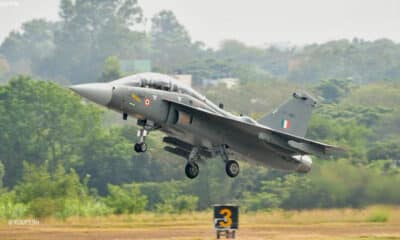Aerospace
Comparison of the Tejas Mark1 vs korean T-50 Golden eagle

In this article, we shall compare two fighter aircraft: the KA T-50 from Korea and the Tejas Mark 1 from India. Both fighter jets are unique in their long-term capability and combat power.
Tejas mark 1
The Tejas MK1 is an Indian aircraft with a single engine, a delta wing, and a light multirole fighter. It was created by the Aeronautical Development Agency. Within its class of modern supersonic combat aircraft, it is the smallest and lightest. Tejas is the second supersonic fighter created by HAL, and Tejas Mark2 is expected to be ready for serial production by 2026. Tejas Mark 1 currently has 65 percent by value and 75.5 percent by number of line replaceable units in 2022, according to indigenous content.
The Tejas’ design was completed in 1990 and has a short tailless compound delta wing with inherent relaxed static stability, making a digital FBW flight control system necessary for improved manoeuvrability. The design and system integration of the Tejas primarily made use of Dassault Breguet’s capabilities. According to the CAG, Tejas Mark1 is an IOC standard aircraft. Some of these shortcomings, and lack of combat endurance, were resolved in the Tejas Mark1 FOC configuration. The upgraded Tejas Mark 1A will have a reduced turnaround time. Tejas Mark 1A’s design work is progressing, and subsystem testing will be finished by 2021, according to HAL Chairman Director R Madhavan.
A Tejas Mk1a costs $43 million, and it has successfully tested firing the Python-5 high off-bore sight (HOBS) and close combat missile, further validating the upgraded I-Derby ER capabilities. Tejas Mark 1 BVR missiles are BVRAAM capable, having a generally expanded flight envelope and had greater angle of attack. It used UTTAM AESA radar, which has a range of 150–200 km and it can track an object of 2 msq.
The Tejas Mark 1A, a modified version of the Tejas Mark 1, will contain an AESA radar, a new digital flight control computer, a new electronic warfare suite, and updated avionics. Tejas is an eight-hard point precision weapon launcher that can accommodate a variety of air-to-air missiles, anti-ship missiles, unguided rockets, and conventional/retarded bombs. Tejas MK1 is better combat fighter than Korean Kai FA-50.
Korean kai T-50 golden eagle
The Kai T-50 Golden Eagle is a South Korean advanced supersonic jet trainer that was created in collaboration with Lockheed Martin. It is also a light combat aircraft and nation’s first supersonic aircraft. In 2005, the aircraft started flight operations with the ROKAF. The TA-50 light attack aircraft and the FA-50 light combat aircraft are now part of the programme, which originally included trainers. KAI has confirmed that it has been given a contract to provide Indonesia with another batch of T-50s in July 2021.
TA-50 now features a triple-redundant digital fly by wire, which is one step less than that quadruplex fly by wire. The T-50 Golden Eagle design is substantially based on the F-16 Fighting Falcon, and they share several similarities. They both use a single General Electric F404-102 turbofan engine, licenced to Samsung Techwin and improved with a FADEC system jointly developed by General Electric and KAI.
The price of a T/A-50 is $30 million, but this price does not include the integration of the missile that the countries are desiring, as a result the price will typically be in the Tejas range or even higher. The T-50 employs ELTA 2032 radar, which has a tuning difference and a 150km range for 5msq. The NEOS used in the T-50 is the first avionics operating system and the only real-time operating system created by an Asian business. It is certified by both IEEE POSIX and DO178B.
An ELTA EL/M-2032 fire control radar is included with the TA-50 variant. The T-50 is outfitted with an HG9550 radar and a Honeywell H-764G embedded global positioning/inertial navigation system. Since this is a training aircraft, just a few missiles have been installed, however they have committed to do the bare minimum missiles.
| Specifications | Tejas Mark 1 | Korean T-50 golden eagle |
| Crew | 1 or 2 | 2 |
| Length | 13.2 m (43 ft) | 13.144 m (43 ft) |
| Wingspan | 8.2 m (26 ft) | 9.45 m (31 ft) |
| Height | 4.4 m (14 ft) | 4.94 m (16 ft) |
| Wing area | 38.4 m2 (413 sq ft) | 23.69 m2 (255.0 sq ft) |
| Empty weight | 6,560 kg (14,462 lb) | 6,470 kg (14,264 lb) |
| Max takeoff weight | 13,500 kg (29,762 lb) | 12,300 kg (27,117 lb) |
| Range | 1,850 km (1,150 mi, 459 nmi) | 1,851 km (1,150 mi, 999 nmi) |
| Service ceiling | 16,000 m (53,500 ft) | 14,630 m (48,000 ft) |
| g limits | +9/−3.5 | +8/ −3 |
| Thrust/weight | 0.94 | 0.96 |
| Maximum speed | 1,980 km/h (1,230 mph, 1,070 kn) | 1,837.5 km/h (1,141.8 mph, 992.2 kn) |
| Fuel capacity | 2,458 kg (5,419 lb) | 2,690 kg (5,920Ib) |

Aerospace
India is set to build a central command for the Air Traffic Control system, called ISHAN

India’s air traffic growth has led to increased responsibilities for air traffic control. The Airports Authority of India (AAI) is considering centralizing air traffic control for aircraft, dividing the country into four regions. The goal is to consolidate India’s segmented airspace into a single entity to improve air traffic management (ATM) efficiency, safety, and smoothness.
Recently, the AAI invited expressions of interest to develop a detailed project report for the Indian Single Sky Harmonized Air Traffic Management (ISHAN) initiative in Nagpur. Under this plan, air traffic controllers in Nagpur would handle domestic flights flying above 25,000 feet, eliminating the need for coordination among controllers in different regions.
For domestic regional flights operating above 25,000 feet, control would shift to the central command in Nagpur. This consolidation aims to enhance airline operations, increase flight handling capacity, and reduce congestion and flight times for passengers.
Currently, the AAI provides ATM services over Indian airspace and adjoining oceanic areas, covering over 2.8 million square nautical miles. This airspace is divided into four flight information regions (FIRs) in Delhi, Mumbai, Kolkata, and Chennai, along with a sub-FIR in Guwahati.
FIRs are responsible for providing air traffic services, including weather information, visibility, and search and rescue assistance. The proposed unification under the ISHAN initiative aligns with the projected growth of the aviation industry, which anticipates a doubling of domestic passenger traffic by 2030.
Aerospace
Does AirAsia show interest in Comac aircraft in the future?

Tony Fernandes, CEO of Capital A, operating as AirAsia Group, recently paid a visit to the facilities of COMAC on April 2, 2024, and was thoroughly impressed by what he witnessed.
C919 already securing nearly 1000 orders
COMAC, known for its homegrown aircraft, has launched two promising jets: the ARJ21 and the C919 aircraft. Both aircraft are gaining popularity in the Chinese market, with the C919 already securing nearly 1000 orders from various airlines.
Fernandes expressed his admiration for COMAC’s achievements in aircraft manufacturing, acknowledging the immense challenge it entails. His visit underscored the realization that AirAsia now has a viable third option when it comes to selecting aircraft for its fleet.
During his tour, Fernandes was delighted by the innovation and technology evident in COMAC’s aircraft production and the company’s commitment to long-term partnerships.
He noted that many Western companies have shifted away from prioritizing loyalty and customer service, opting instead for short-term gains and a narrow definition of success.
Last month, COMAC embarked on an international tour, showcasing demonstration flights to neighboring countries, particularly Indonesia and Malaysia. Fernandes believes that the positive impression left by COMAC during his visit opens up new opportunities for collaboration.
Fernandes emphasized COMAC’s remarkable achievements
The shared values of loyalty, customer service, and long-term vision align closely with AirAsia’s ethos, making collaboration with COMAC appealing. With a focus on innovation and excellence, both companies stand to benefit from a partnership grounded in trust and a shared commitment to success.
Indonesia and China have already collaborated in validating and maintaining the airworthiness of the ARJ21 aircraft, indicating a solid foundation for future partnerships.
In his statement, Fernandes emphasized COMAC’s remarkable achievements and genuine desire for long-term partnership, highlighting the absence of ego and a genuine willingness to succeed together. He marveled at COMAC’s fully automated, AI-driven factory, a testament to their dedication to innovation and efficiency.
Fernandes criticized Western firms for prioritizing short-term gains over loyalty, customer service, and long-term strategy, emphasizing the importance of understanding customers’ needs and collaborating to achieve success.
Aerospace
Indigo will soon launch Air Taxi Service in India

InterGlobe Enterprises, the parent brand of IndiGo, is set to revolutionize travel in India with its upcoming air taxi service.
Scheduled for a potential launch in 2026, this innovative venture promises a seamless journey for passengers between two bustling hubs. Delhi and Gurgaon in Haryana. The forthcoming service is projected to revolutionize the daily commute, offering passengers a swift aerial journey covering the distance in a mere 7 minutes.
This remarkable efficiency contrasts starkly with the conventional 90-minute drive, underscoring the immense time-saving potential for commuters. The anticipated fare, ranging from Rs 2,000-3,000, makes this innovative mode of transport not only swift but also remarkably competitive in pricing.
At the heart of this ambitious endeavor lies a strategic partnership with Archer Aviation, a pioneer in electric vertical takeoff and landing (eVTOL) aircraft technology. Under this collaboration, Archer will supply 200 state-of-the-art eVTOL aircraft, representing an investment of US$ 1 billion. These cutting-edge aircraft, capable of accommodating up to four passengers alongside the pilot, epitomize the future of sustainable air travel.
Powered by six battery packs, Archer’s eVTOL aircraft boast rapid charging capabilities, enabling a swift turnaround between flights. With a charging time of just 30-40 minutes, these eco-friendly aircraft ensure minimal downtime, maximizing operational efficiency.
Similar services are anticipated to be introduced by the joint venture in Bengaluru and Mumbai as well. Nevertheless, the service rollout period has not yet been made public by the company. Next year, it is anticipated to get its certification. Following this, the company will start the certification procedure with the Directorate General of Civil Aviation (DGCA).

























